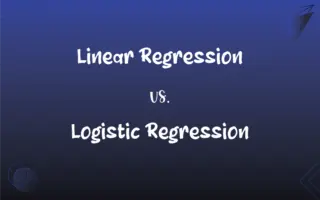ASCII vs. EBCDIC: What's the Difference?
Edited by Aimie Carlson || By Harlon Moss || Published on February 18, 2024
ASCII and EBCDIC are both character encoding systems; ASCII is widely used and standardized, while EBCDIC is less common and IBM-specific.

Key Differences
ASCII, the American Standard Code for Information Interchange, is a character encoding standard for electronic communication. EBCDIC, the Extended Binary Coded Decimal Interchange Code, developed by IBM, is another encoding system used in older IBM mainframes. Both ASCII and EBCDIC represent text in computers, telecommunications equipment, and other devices.
In ASCII, 128 specified characters are encoded into seven-bit integers as its basic alphabet. EBCDIC, on the other hand, uses an eight-bit encoding, providing a larger number of available characters. While ASCII is widely adopted in most systems, EBCDIC remains in use primarily in IBM systems.
ASCII was designed for compatibility with telegraphy, and its character set is now universal in computing. EBCDIC, though less standardized, was designed for compatibility with IBM's punch card format. ASCII and EBCDIC differ significantly in their character set arrangements and values.
ASCII includes control characters and printable characters, with the latter including digits, letters, and punctuation marks. EBCDIC's character set also includes control and printable characters, but with different arrangements and some additional control codes specific to IBM's requirements.
Converting between ASCII and EBCDIC can be challenging due to their different character set encodings. ASCII has become the de facto standard for modern operating systems and programming languages, whereas EBCDIC's use is now largely confined to legacy systems.
ADVERTISEMENT
Comparison Chart
Encoding Bits
7-bit encoding, making it more efficient for modern computing.
8-bit encoding, resulting in a larger character set.
Character Set
Includes 128 characters, focusing on English language.
Includes 256 characters, with more specialized symbols.
Usage
Universally used in most modern systems and internet protocols.
Primarily used in older IBM mainframes and legacy systems.
Compatibility
Designed for telegraphy and compatible with most computer systems.
Designed for IBM punch cards, less compatible with non-IBM systems.
Layout
Has a more logically organized character set.
Character set layout is considered less intuitive.
ADVERTISEMENT
ASCII and EBCDIC Definitions
ASCII
ASCII is a standard for character encoding in computers and electronic devices.
The text file is saved in ASCII format for universal readability.
EBCDIC
EBCDIC supports a wider range of characters than ASCII due to its 8-bit encoding.
EBCDIC's 8-bit structure allows it to represent additional special characters.
ASCII
ASCII is limited to 128 characters, making it efficient but less diverse.
Due to ASCII's limitations, it cannot represent characters from non-Latin scripts.
EBCDIC
EBCDIC is a character encoding system used primarily in IBM mainframes.
The legacy database uses EBCDIC encoding, requiring conversion for modern systems.
ASCII
ASCII stands for American Standard Code for Information Interchange.
ASCII was developed in the early 1960s to standardize digital communication.
EBCDIC
EBCDIC is less common and less standardized compared to ASCII.
Converting data from EBCDIC to ASCII is necessary when moving to newer systems.
ASCII
ASCII is foundational in modern computing and internet communication.
Web pages often use ASCII to encode their content.
EBCDIC
EBCDIC was designed for compatibility with IBM's early hardware.
EBCDIC encoding reflects the legacy of IBM's punch card systems.
ASCII
ASCII assigns numerical values to letters, digits, and control characters.
In ASCII, the letter 'A' is represented by the number 65.
EBCDIC
EBCDIC stands for Extended Binary Coded Decimal Interchange Code.
EBCDIC is an older encoding system, contrasting with the more universal ASCII.
ASCII
A standard for assigning numerical values to the set of letters in the Roman alphabet and typographic characters.
EBCDIC
A standard code that uses 8 bits to represent each of up to 256 alphanumeric characters.
ASCII
Persons who, at certain times of the year, have no shadow at noon; - applied to the inhabitants of the torrid zone, who have, twice a year, a vertical sun.
EBCDIC
A 8-bit code for representing alphanumerical information in a digital information storage medium. It was used expecially on IBM mainframes, and differed substantially from the ASCII code.
ASCII
The American Standard Code for Information Interchange, a code consisting of a set of 128 7-bit combinations used in digital computers internally, for display purposes, and for exchanging data between computers. It is very widely used, but because of the limited number of characters encoded must be supplemented or replaced by other codes for encoding special symbols or words in languages other than English. Also used attributively; - as, an ASCII file.
ASCII
(computer science) a code for information exchange between computers made by different companies; a string of 7 binary digits represents each character; used in most microcomputers
FAQs
How many characters does EBCDIC support?
EBCDIC supports 256 characters, offering a broader range than ASCII.
Does EBCDIC have an advantage over ASCII?
EBCDIC's main advantage is its compatibility with certain IBM legacy systems, but it's generally less efficient than ASCII.
Is ASCII still used today?
Yes, ASCII is widely used today in computing and internet protocols.
Can ASCII represent non-English characters?
Standard ASCII is limited to English characters, but extended versions like UTF-8 can represent a wide range of characters.
What is ASCII?
ASCII is a 7-bit character encoding standard used in computers and electronic communications.
How many characters does ASCII support?
ASCII supports 128 characters including control and printable characters.
Why was ASCII developed?
ASCII was developed to standardize the representation of text in electronic devices.
How is ASCII used in web development?
ASCII is used in web development for encoding HTML and source code.
Is EBCDIC still in use?
EBCDIC is primarily used in legacy IBM systems and is less common in modern computing.
Why was EBCDIC developed?
EBCDIC was developed by IBM to work with its hardware, especially punch card systems.
What is EBCDIC?
EBCDIC is an 8-bit character encoding system used mainly in older IBM mainframes.
What does ASCII stand for?
ASCII stands for American Standard Code for Information Interchange.
What does EBCDIC stand for?
EBCDIC stands for Extended Binary Coded Decimal Interchange Code.
Is ASCII suitable for international use?
ASCII by itself is limited for international use due to its focus on English characters, but extended versions like UTF-8 support international characters.
How does EBCDIC handle non-English characters?
EBCDIC has different versions for different languages and regions, but it's generally less flexible than modern Unicode standards.
Can EBCDIC be converted to ASCII?
Yes, EBCDIC can be converted to ASCII, but the process requires careful mapping of character sets.
What are the limitations of EBCDIC?
EBCDIC's limitations include its lesser compatibility with non-IBM systems and a less intuitive character set layout.
Are ASCII and EBCDIC compatible with each other?
ASCII and EBCDIC use different encoding schemes, making them incompatible without conversion.
What are the limitations of ASCII?
The main limitation of ASCII is its inability to natively represent characters outside of the English alphabet.
What is the future of ASCII and EBCDIC?
ASCII, especially in extended forms like UTF-8, remains fundamental in modern computing, while EBCDIC is gradually being phased out in favor of more universal encoding standards.
About Author
Written by
Harlon MossHarlon is a seasoned quality moderator and accomplished content writer for Difference Wiki. An alumnus of the prestigious University of California, he earned his degree in Computer Science. Leveraging his academic background, Harlon brings a meticulous and informed perspective to his work, ensuring content accuracy and excellence.
Edited by
Aimie CarlsonAimie Carlson, holding a master's degree in English literature, is a fervent English language enthusiast. She lends her writing talents to Difference Wiki, a prominent website that specializes in comparisons, offering readers insightful analyses that both captivate and inform.































































